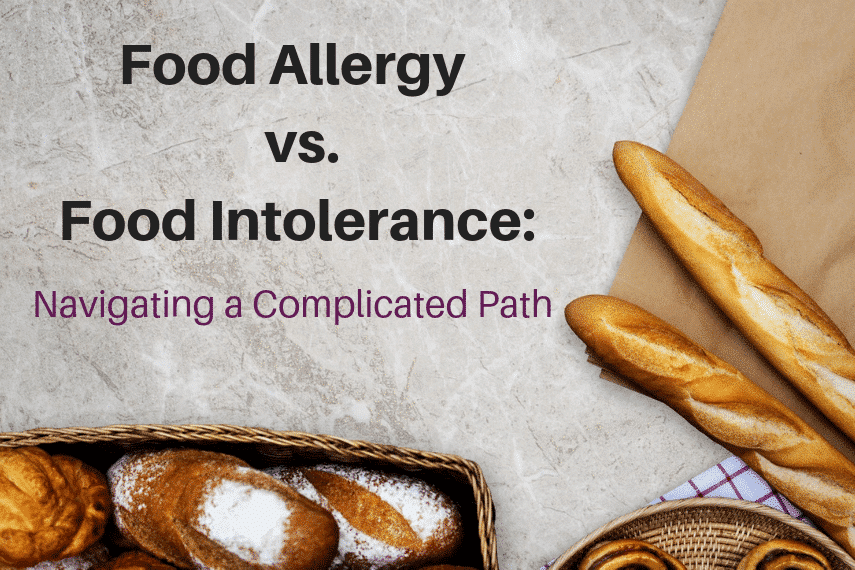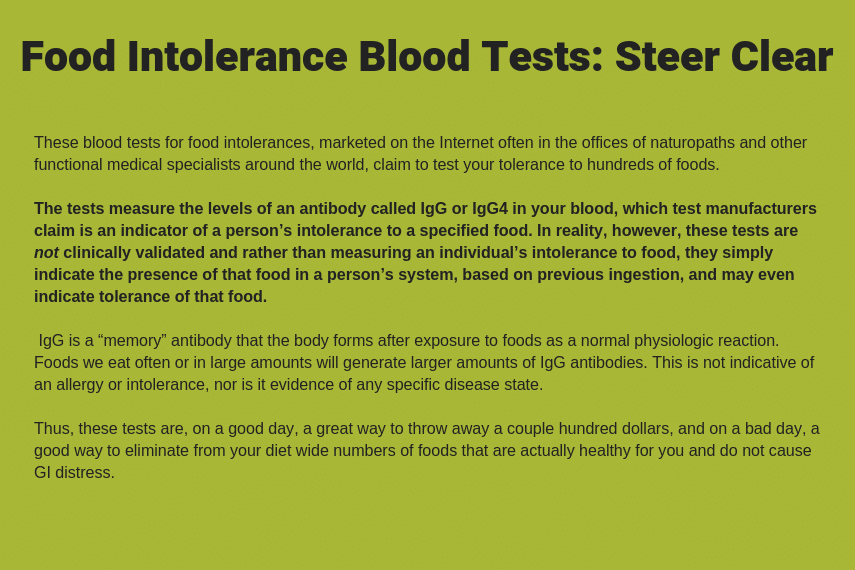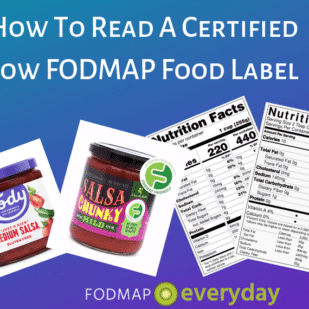Food Allergy vs. Food Intolerance: Navigating a Complicated Path
As a Monash- and Kings College-trained low FODMAP dietitian, a Success Team Member for FODMAP Everyday®, and a moderator of several Facebook groups for individuals following the Low FODMAP diet, I receive a lot of questions about testing for and diagnosing food allergies and intolerances. This article aims to shed some light on this topic and provide some scientifically based recommendations readers can use to navigate their own journey in delineating between food allergies and food intolerances.
Tests & Professionals Should Be Vetted
Take a quick look around the Internet and you can’t help but stumble over dozens of companies marketing food intolerance tests or “functional” medical practitioners and “integrative” nutritionists who recommend these tests for their clients with gut issues. Please note that the terms “functional” and “integrative” can be used by highly accredited hospitals and medical doctors (MDs), but the terms have been co-opted by those with far less credentialed backgrounds, so please proceed with caution. For additional insight, please read our article on Dietitians vs. Nutritionists.
It can be confusing to figure out the difference between food allergies and food intolerances, and how one goes about assessing what’s truly going on in their gut.
Food Allergies vs. Food Intolerances: What’s the Difference?
Food Allergies Can Range from Mild to Life Threatening
In general terms, a food allergy is an immune-system mediated reaction that the body mounts to a food substance. This is when a specific type of food substance is perceived as an “invader” by your body’s immune system, triggering a cascade of reactions, including the production of a group of antibodies called Immunoglobin E (IgE), in order to fight off the invader.
Similar to other types of allergies, an allergic reaction to a food affects multiple organs in the body, with symptoms typically showing up anywhere from a few minutes to several hours after eating the food in question. However, serious food allergy can cause rapid, even life-threatening reactions in an individual after eating only a tiny amount or by touching or inhaling the food substance. It usually takes very little of a substance to trigger a reaction in someone with a food allergy, especially in the case of anaphylactic allergies, such as peanut allergies.
Symptoms of food allergy can also include tingling or itching of the mouth; skin issues such as hives, swelling or eczema, GI issues such as abdominal pain, nausea, diarrhea or vomiting, or respiratory issues like wheezing, runny nose and congestion or less dire issues with breathing.
Food Intolerances Are Not Life Threatening
Food intolerances are another beast altogether and are not characterized by immune system activation; affecting the digestive system instead. In this situation, it’s not an aggressive and deadly invader that’s attacking your system, but more like the irritating next-door neighbor that your body just really doesn’t get along with. In most cases of food intolerance, the food in question has to be eaten and make its way into the intestines before it causes symptoms. Thus, generally, food intolerance reactions are triggered anywhere from 30 minutes to 24 hours after eating a “trigger” food.
Food intolerances arise due to the GI tract’s limited ability to fully digest and absorb certain foods (thereby leading to uncomfortable symptoms as your body tries to figure out how to deal with this malabsorption).
This malabsorption can be attributed to insufficient levels of certain digestive enzymes in the gut, altered GI motility, defects in certain transporters that help with food absorption and/or dysregulation of normal gut-brain communication. For example, lactose intolerance stems from a deficiency in lactase, which is the enzyme required to digest lactose properly. In some cases, food intolerance can be trigged by a secondary disease, such as celiac disease, which, when untreated, may affect the small intestine’s ability to digest and absorb lactose.
Symptoms of food intolerance run the gamut from GI issues such as nausea, heartburn, gas and bloating to skin, respiratory or behavioral issues.
In most cases of food intolerance, “dose” or the amount eaten of the food in question is important, and each individual may have significantly different tolerance levels to the same foods.
The low FODMAP diet is designed to address specific issues of food intolerance, e.g. the malabsorption of short-chain carbohydrates called FODMAPs (fermentable oligo- di- and monosaccharides and polyols). The three-phase process of this diet helps individuals identify which types of food are problematic and in which amounts, while also ensuring minimal restriction of nutritious foods.
How Do You Know What You’re Dealing With?
First of all, self-diagnosing a food-related allergy or intolerance is not the way to go!
Here are some tips for finding the answers for what’s happening in your gut.
- Compile a complete symptom and food diary for a month or more. Keep track of what you eat, which symptoms arise, how long after eating you experience symptoms, and how often you experience these reactions. These patterns can be very important in starting the investigative process.
- See a board certified and licensed specialist. If you truly suspect food allergy, see a board certified and licensed allergist or immunologist as they are the most qualified to make food allergy diagnoses. If you suspect intolerances, see your gastroenterologist and/or GI registered dietitian. Non-MD functional medicine specialists or general nutritionists are not appropriate for these situations.
- Do not remove any foods from your diet until you’ve been requested to by your medical doctor or healthcare team, such as your registered dietitian. There are certain tests, such as the blood test for celiac disease, which require you to be eating the target food in question for a period of time prior to a test to ensure proper testing validity.
- Conduct valid tests. This can be where things get dicey!
For food allergies, blood tests and/or skin prick tests that measure the amount of IgE produced are scientifically validated tests to diagnose true food allergies with a fairly high degree of confidence, alongside a complete symptom and medical history.
These tests (also previously called RAST or ImmunoCap tests) are conducted in a medical facility under the supervision of a physician or allergist, and are not something you can test at home. An oral food challenge under close medical supervision may also be used to test for or verify a food allergy.
Steer clear of the following: ELISA/ACT, provocation, vega eletrodermal and applied muscle tests, as they are not backed by scientific evidence.
In the case of food intolerances, despite what the Internet wants you to believe, there are very few scientifically validated tests. In the case of lactose or fructose intolerance, breath tests may be used to identify malabsorption of these sugars in the gut, but these are often fraught with errors in execution and interpretation of the tests.
For example, it’s well known that individuals may test positive for fructose malabsorption, but do not actually experience any symptoms. And, children often malabsorb fructose up until a certain age, but don’t necessarily need to eliminate this sugar as it is a temporary scenario.
Blood tests for food intolerances (IgG antibody tests) are not scientifically valid (see box below for further details), nor are the following types of tests: ALCAT, MRT and the LEAP diet, hair analysis or cytotoxic food testing.
The medical, allergy and nutrition communities also universally (and strongly) recommend against these blood tests for food intolerances:
- American Academy of Allergy, Asthma and Immunology & American College of Allergy, Asthma and Immunology:“IgG and IgG subclass antibody tests for food allergy do not have clinical relevance, are not validated, lack sufficient quality control, and should not be performed.”
- Academy of Nutrition and Dietetics: ”there are a variety of non evidence-based tests that should not be used for diagnosing a food allergy [including allergenic specific IgG tests].”
- Australasian society of clinical immunology and allergy: “Not only do these tests lack any scientific rationale, but have been shown to be inaccurate and poorly reproducible when subjected to careful study. Treatment based on inaccurate results is not only misleading, but can result in ineffective and sometimes harmful treatments, and delay more effective therapy.”
- British Dietetic Association: “There are [also] many commercially available tests that claim they can diagnose food hypersensitivity. These should be avoided as they have no scientific basis and can be harmful when multiple foods are excluded without reason and if they are not reintroduced under guidance of a dietitian.”
- European Academy of Allergy and Clinical Immunology, “Food specific IgG4 [testing] does not indicate (imminent) food allergy or intolerance, but rather a physiological response to the immune system after exposition to food components. Therefore, testing of IgG4 to foods is considered as irrelevant for the laboratory work-up of food allergy or intolerance and should not be performed in case of food-related complaints.”
- National Institute of Allergies and Infectious Disease, “The utility of these tests has not been validated for the diagnosis of FA [food allergy] and may result in false positive or false negative diagnoses, leading to unnecessary dietary restrictions or delaying the appropriate diagnostic workup, respectively.”
Skip Self-Diagnosis & Home Tests, Work with a RD & Don’t Give Up!
In reality, the best way to diagnose and treat food intolerances is by working with a registered dietitian to implement a structured elimination diet; the low FODMAP diet is an elimination diet aimed at determining tolerances to FODMAPs. An elimination diet is a process designed to identify food intolerances and test for each person’s unique tolerance levels.
During an elimination diet, suspected trigger foods are eliminated and then reintroduced, one at a time, for a period of time, in measured doses. By focusing on one single food or food group at a time, you are able to pinpoint the exact food and amount that causes GI symptoms.
Massive elimination diets, such as Whole30 (which eliminates added sugar, dairy, grains, legumes, alcohol, certain food additives and highly processed food) can cause significant confusion, because it’s not clear which specific food is an issue when dozens of foods were eliminated all at once. And, these types of aggressive elimination diets often throw the nutritional “baby out with the bathwater” by eliminating a lot of healthy foods, creating risk for nutritional deficiencies.
Bottom line: Dietitians are specially trained to evaluate food-related symptoms and identify other issues that may be affecting digestion. Internet gurus are not.
Do not rely on home-based tests unless your doctor has specifically recommended them. Most of these are not regulated by the US Food & Drug Administration and may be of dubious quality or validity.
Follow your healthcare providers’ advice. In the case of food allergies or an autoimmune disorder like celiac disease, even a small amount of the substance in question can trigger significant and even deadly reactions, so you must avoid these foods completely. However, with food intolerances, it’s generally a question of personal preference and levels of tolerance. You may be willing to tolerate some mild symptoms on occasion or you may not. Ask your provider what is recommended for your specific situation.
You May Want To Read:
IBS in Children: What Do You Do?
What If I Have Both IBS & IBD?
How To Read A Low FODMAP Certified Product Label
How to Read a FDA Nutrition Facts Label
What If A Food Hasn’t Been Lab Tested For FODMAPs?
What Is a Low FODMAP Serving Size?
High FODMAP Foods with Low FODMAP Serving Sizes
Summary
If you suspect food allergies or intolerances, it’s important to identify exactly what you’re dealing with rather than simply operating on trial and error. The treatment for and consequences of each situation will differ significantly, and it’s vital to your health to ensure you’re following the right nutritional path. Additionally, over-elimination of foods can lead to nutritional deficiencies, lack of energy and long-term health concerns.
Editor’s Note: This article represents the experience and expertise of the author. At FODMAP Everyday® contributors are chosen for their unique voices, expertise and their credentials if they are sharing medically based information. Our goal is to educate you, the consumer, so that you can make informed decisions about your own health care.
Read more on this topic:
- Academy of Nutrition and Dietetics, https://www.eatrightpro.org/-/media/eatrightpro-files/practice/position-and-practice-papers/practice-papers/practicepaperroleofrdnfoodallergies.pdf
- American Academy of Allergy Asthma and Immunology, https://www.aaaai.org/conditions-and-treatments/library/allergy-library/IgG-food-test
- British Dietetics Association, https://www.bda.uk.com/foodfacts/food_allergy_intolerance_testing
- Food Allergy Research & Education, https://www.foodallergy.org/life-with-food-allergies/food-allergy-101/diagnosis-testing/unproven-diagnostic-tests
- Food & Nutrition Magazine, https://foodandnutrition.org/july-august-2017/the-controversial-conundrum-of-food-sensitivities/
- Guardian, https://www.theguardian.com/society/2015/aug/16/leave-it-out-are-food-intolerances-fact-or-fad-gluten-dairy-free-from-coeliac
- Science-based Medicine ,https://sciencebasedmedicine.org/igg-food-intolerance-tests-what-does-the-science-say/
- Unproven Diagnostic Tests for Adverse Reactions to Foods, Kelso, John M. The Journal of Allergy and Clinical Immunology: In Practice , Volume 6 , Issue 2 , 362 – 365, https://www.jaci-inpractice.org/article/S2213-2198(17)30704-3/fulltext#sec1
- Tonic, https://tonic.vice.com/en_us/article/43778n/food-intolerance-tests-are-shoddy-science-and-traps-for-disordered-eating










Dear Dede, as a human with some severe (and tested) food allergies – peanut, shellfish and aloe, i totally agree that every food allergy should be verified by extensive tests at the MD. Since I am also allergic to some pollen, I would like to point out, that at least the European allergy organization is warning patients and doctors that a body can react allergic to food coming from the same plant family e.g. birch and strawberry and that patients with pollen allergies and digestive issues should get tested for those allergies as well.
I would consult with your allergist. We cannot give medical advice. Good luck! Your thought process makes sense to me.